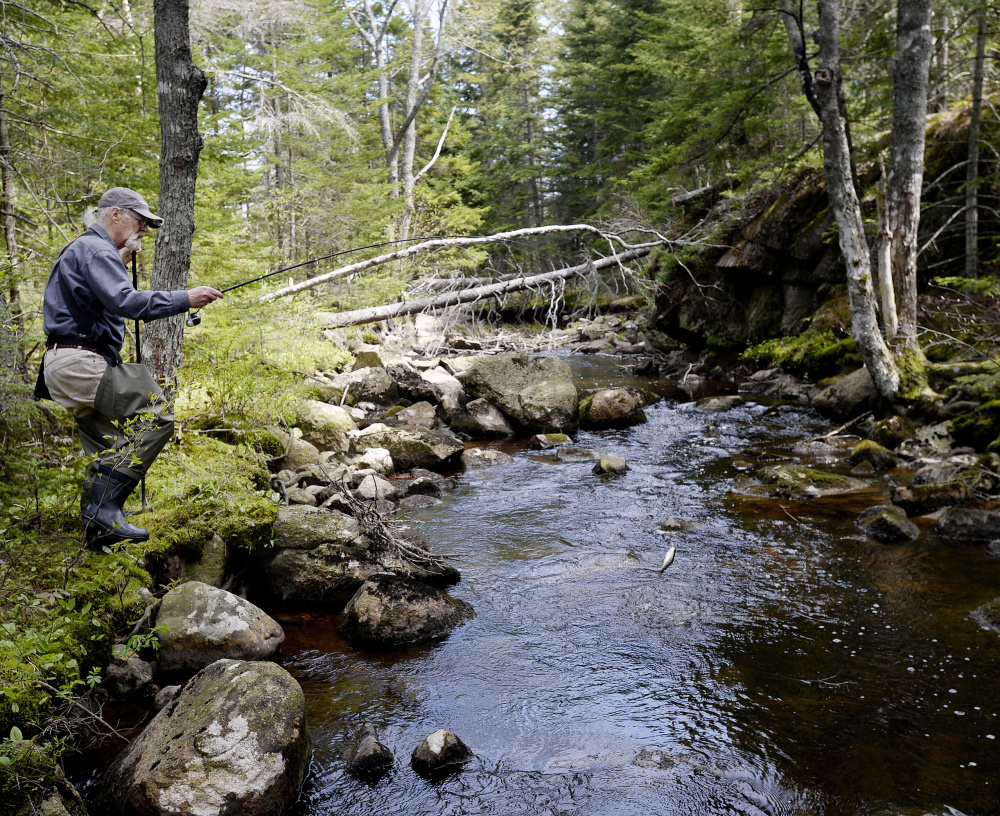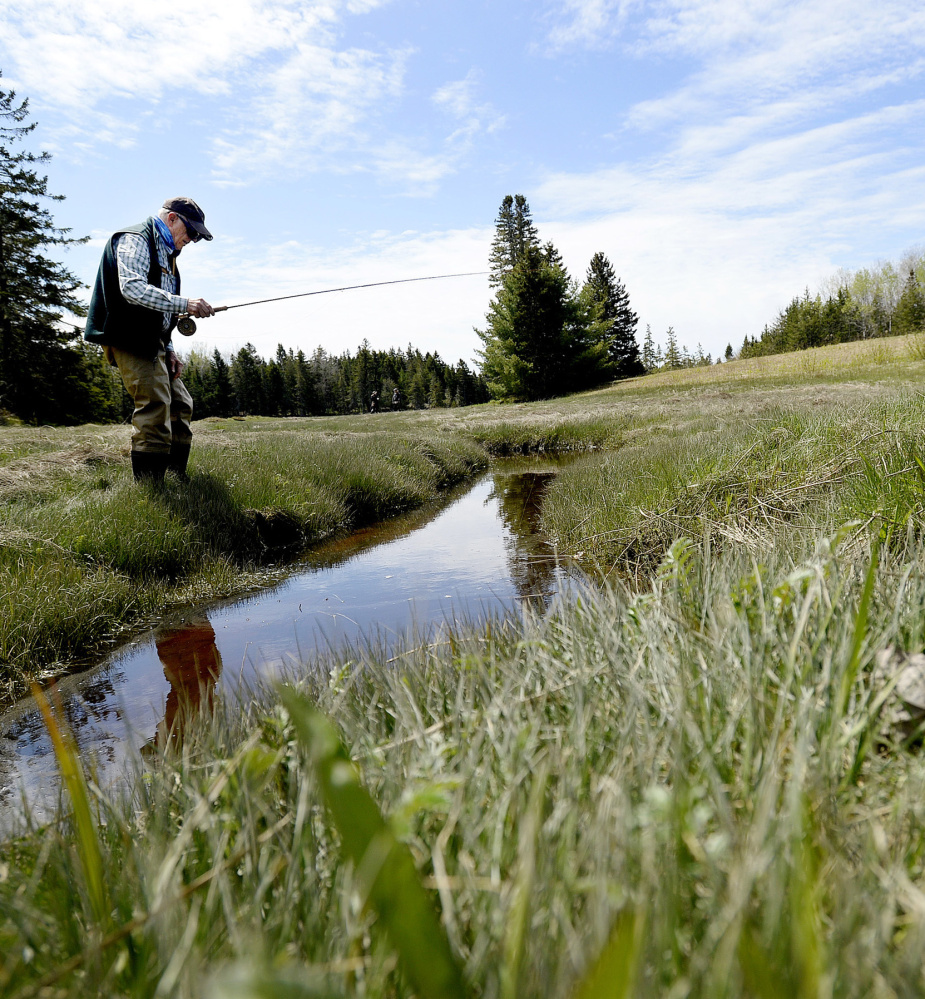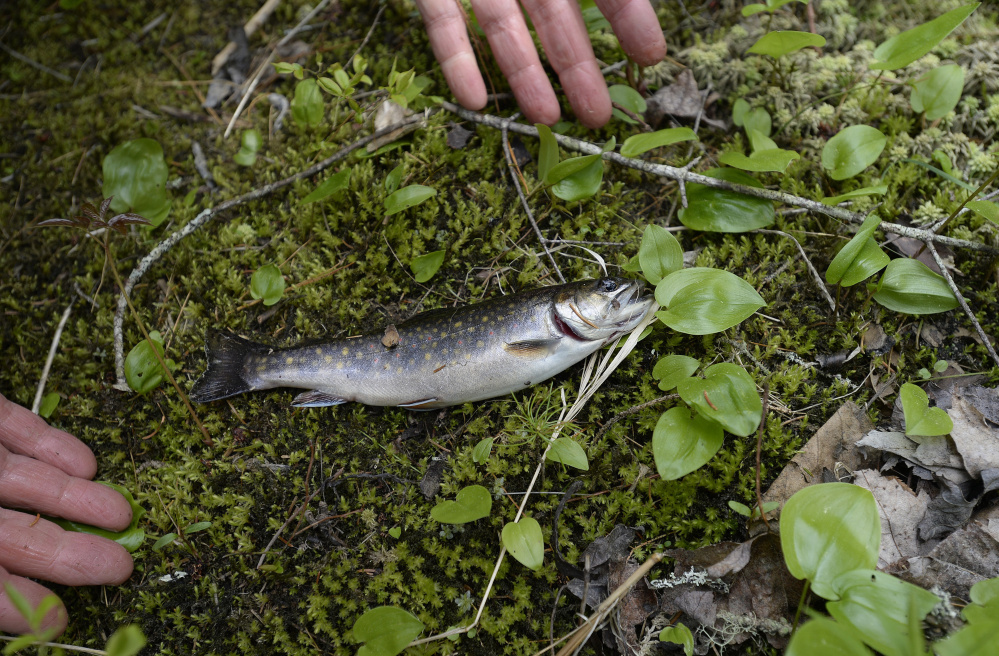GOULDSBORO — The Schoodic Peninsula in Downeast Maine offers picturesque views of inlets, the rocky coast and the ocean beyond.
But fly fishermen Steven DeWick of Woolwich and Randy Clark of Dresden are not here for the scenery. On this morning, they’re deep in a thorny patch of forest, looking and listening for small streams and bubbling waterfalls. They’re also getting swarmed by black flies.
But they don’t notice.

Steven DeWick of Woolwich inspects a tributary while hunting in the Schoodic Peninsula area for remote streams with sea-run brook trout.
After all, if there are bugs here, there could be brook trout. DeWick and Clark are part of a team of 20 fishermen searching for sea-run brook trout as part of the Coastal Stream Survey Project. The study gathers data in hopes of better understanding the sea-run brook trout population, which biologists know little about.
The project, now in its third year, is coordinated by Trout Unlimited, Maine Audubon, the Maine Department of Inland Fisheries and Wildlife, and the Sea Run Brook Trout Coalition of Newburyport, Massachusetts.
“Salters are kind of the holy grail of fishing,” Clark says. “Fishermen who find them don’t say where they catch them. It’s secretive. They are one thing on the bucket list.”
A sea-run brook trout, or salter, is a brook trout that spawned in freshwater but moves to the ocean, but biologists do not know why or when. A salter looks like a freshwater brook trout but has a silvery color and tends to have a pronounced belly.
“Most trout and salmon species can tolerate saltwater. Some of them, like steelheads and Atlantic salmon, have a history of long migrations in saltwater. The sea-run (brook trout) is somewhere in between. But we don’t know where because there are not that many studies of them. At some point it’s accessing salt water for some reason and we don’t know why,” said Jeff Reardon, Trout Unlimited’s brook trout project leader in Maine.
A report by Trout Unlimited in 2006 showed that Maine is the last stronghold in the Northeast for wild brook trout, with 97 percent of the intact wild lake and pond brook trout populations in the eastern United States.

Randy Clark of Dresden inspects a trout he caught in a brook in the Schoodic Peninsula area. Shawn Patrick Ouellette/Staff Photographer
Maine also has the majority of streams with sea-run brook trout in the Northeast. A 2013 survey showed the state has 317 of 457 such streams between Maine and New York.
“There is no question that the best resource for sea-run brook trout is the state of Maine. It has to do with the number of rivers there and the relative lack of modern development, and the lack of pollution,” said Geoffrey Day, the executive director of the Sea Run Brook Trout Coalition.
In the first two years of the Coastal Stream Survey Project in Maine, brook trout were confirmed in 58 of 78 coastal streams surveyed by volunteers.
Two weeks ago, Clark and DeWick searched tidal water at the mouths of streams that state biologists have not stocked and have not surveyed.
They claim they catch a salter in less than half of the streams they fish. Not great odds for two experienced fly fishermen, but the satisfaction when they hook a brookie is priceless to them.
But on this day, they got lucky.
They parked on a local road near the Schoodic Peninsula and started hiking toward a salt marsh. They pointed to beer cans, evidence that other fishermen were here. But this is not what Clark is looking for here.
He turns away from the salt marsh and heads toward another tributary buried in a forest. He steps over a rocky waterfall without hesitation, as if he’s been here before, when he has not.
He’s got a hunch.
Looking for the shady, rocky stream bottoms he knows brookies favor, he dips in a worm (which he only fishes with now for the study) and hooks one. Clark notes the size, gets a photo of it and lets it go.
It’s not clear if it’s a sea-run brook trout, or a brook trout swimming close to tidal water, but it is near the coast so the stream is added to the state’s growing list of waters state biologists need to investigate.
Back at the truck, DeWick takes out his GPS to mark the spot and the two men smile.
“When I heard the waterfall, I knew, it’s here,” Clark says satisfied. “We’ve slugged through woods for three hours, only to find a little trickle. It might be a very scenic spot, but there are no brook trout there.”
Send questions/comments to the editors.






Success. Please wait for the page to reload. If the page does not reload within 5 seconds, please refresh the page.
Enter your email and password to access comments.
Hi, to comment on stories you must . This profile is in addition to your subscription and website login.
Already have a commenting profile? .
Invalid username/password.
Please check your email to confirm and complete your registration.
Only subscribers are eligible to post comments. Please subscribe or login first for digital access. Here’s why.
Use the form below to reset your password. When you've submitted your account email, we will send an email with a reset code.